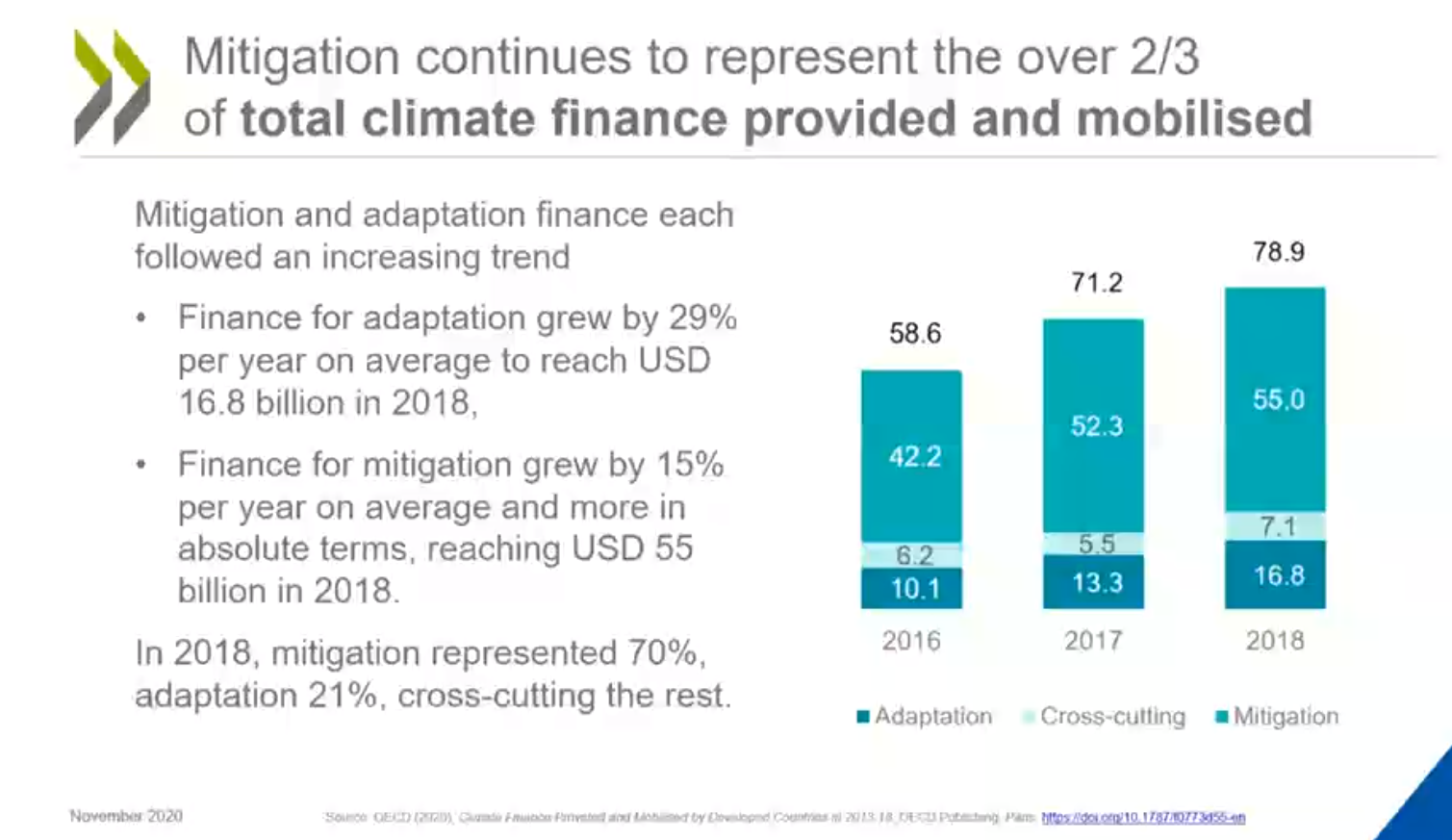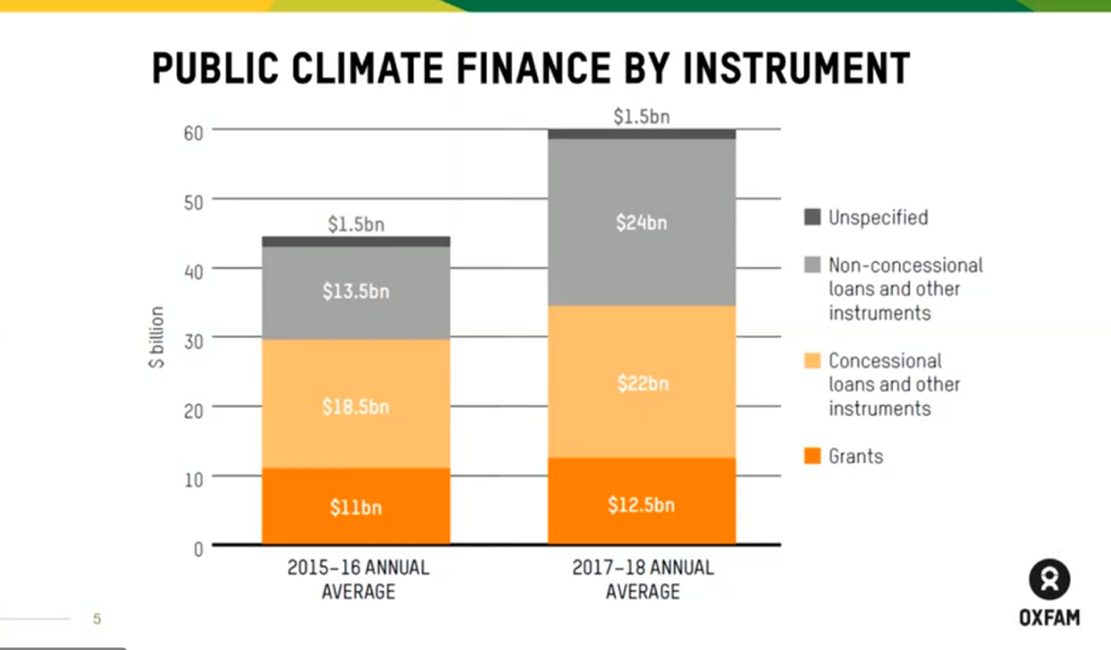Tracking progress towards long-term finance under the UNFCCC
Tracking progress towards long-term finance under the UNFCCC
Kamleshan Pillay, Mairi Dupar and Lisa McNamara of CDKN report from the Long Term Finance workshop convened by the UNFCCC on 27 November 2020, as part of the UN Climate Dialogues.
See also the long series of tweets about the workshop on www.twitter.com/cdknetwork
“We must unite under the promise made five years ago, redouble our efforts to achieve the goals of the Paris Agreement. In this task, finance is the single most important element,” said UNFCCC Executive Secretary Patricia Espinosa, in her opening remarks at the in-session Workshop on Long-term Climate Finance held last week during the UNFCCC Climate Dialogues.
“The truth is, that $100 billion, and even several hundred billion will not be enough to tackle the challenge we are facing. The scale of investment required is in the trillions,” she continued.
Co-facilitated by Zaheer Fakir (South Africa) and Mr. Georg Børsting (Norway), the first of two workshops on long-term finance was held virtually as part of the UNFCCC Climate Dialogues on 27 November 2020 and was attended by over 90 participants, with a further 240 following by public live stream.
The context for long-term finance started at COP16 in Cancun, Mexico, where developed country Parties committed to a goal of jointly mobilising $100 billion per year by 2020 to address the needs of developing countries (decision 1/CP.16, paragraphs 97–101). In accordance with the Bali Action Plan it was also agreed that funds provided to developing countries can come from a wide array of sources, including public and private, bilateral and multilateral sources.
Workshop presenters Jane Ellis of the Organisation for Economic Co-operation and Development (OECD) and Tracey Carty of Oxfam set the scene, by presenting how much climate finance has been provided and mobilised during the past few years.
A panel comprising: Mariama Williams (South Centre), Peter Damgaard Jensen (Institutional Investors’ Group on Climate Change), Amar Bhattacharya (Brookings Institution) and Preety Bhandari (Asian Development Bank) followed up with current examples and details about needs, priorities, policy interventions and finance transacted.
Parties and groups then shared their views on the quality and quantity of climate finance reported, provided, and mobilised in the context of achieving the US$ 100 billion goal. They cited topics including: needs for developing countries, definition of climate finance, grants versus loans, balance between mitigation and adaptation, loss and damage, new and additional finance, co-financing, differentiation of climate finance from Official Development Assistance (ODA), and the private sector’s unique role as a provider, but not as a substitute for public climate finance.
Climate finance flows between 2013 - 2018
The OECD evidence: an upward trend mostly driven by public flows
Jane Ellis of the OECD shared the headline findings of a report on the “Climate finance provided and mobilised by developed countries from 2013 – 2018”. Read her Presentation.
Both mitigation and adaptation finance have followed an increasing trend. Adaptation finance specifically has increased by 29% per year on average to $16.8 billion in 2018, while mitigation finance grew by 15% per year reaching $55 billion by 2018. Financial flows are predominantly going to mitigation, making up 70% of all financial flows, with adaptation at only 21%.
Between 2013 and 2018, the share of loans has grown from 52% to 74% while the share of grants has decreased from 27% to 20% during the same period. Climate finance for Least Developing Countries (LDCs) and Small Island Developing States (SIDS) have received 14% and 2% of total climate finance provided and mobilised, respectively.
The Oxfam evidence: Net assistance lower than reported figures
The Oxfam Climate Finance Shadow report presented by lead author, Tracy Carty, estimates that public climate-specific net assistance is lower than reported figures with an increase from $15–19.5billion per year in 2015–16, to $19–22.5billion per year in 2017–18. For example, in the case of Japan, France and the United Kingdom, the reported financial flows of $9.7, $4.8 and $1.12 billion, respectively, have a grant equivalence of $5, $1.3 and $1.1 billion, respectively. Read her Presentation.
After adjusting for grant equivalence of loans and the relevance of projects to climate change, the climate change specific net assistance may be a third of the reported financial flows. Most loans continue to be counted at their full face value, rather than as the amount of money given to a developing country once repayments, interest and other factors are accounted for (the grant equivalent).
As is the case in the OECD analysis, climate finance provided by grants provided has not changed significantly according to the Oxfam report, while there has been a considerable increase in concessional loans from $18.5billion per year in 2015–16 to $22billion per year in 2017–18. So while climate finance has increased it has been on harder terms.
Why do Oxfam and OECD estimates of financial flows differ?
Further to the decision in Cancun at COP16, modalities for accounting financial resources were agreed at COP24. Beyond the varied sources of climate finance, the financial instruments used to deliver climate finance were also agreed upon – grants, concessional and non-concessional loans, equity, guarantees, insurance, and others. Despite this agreement, there remain contrasting views as to whether climate finance should be tracked and reported at face value and whether climate finance flows should include debt financing.
Are we meeting the needs of LDCs and SIDS?
Amar Bhattacharya of the Brookings Institution suggested that the issue of the value of loans was a “false discussion”, as many of the loans offered were concessional with long terms and low interest rates. In response, Mariama Williams of the South Centre remarked that the high percentage of finance provided through loans was concerning in the case of Least Developing Countries (LDCs) and Small Island Developing States (SIDS) where further debt can place further strain on already-thin public budgets. Preety Bhandari of the Asian Development Bank further emphasised that “adaptation was as a special case where grants were essential, particularly as many projects are not revenue generating”.
Climate, development, or both?
Several discussants highlighted countries’ difficulties in justifying the “climate specificity” of their investment proposals – in order to attract climate-specific financing. Amar Bhattacharya noted that there is an overlap in climate and sustainable development and that “what is good for development should be good for the climate”, providing the example of mass transit project.
In subsequent discussions, other speakers noted that when countries can provide a climate rationale for their investment proposals, this serves to elevate the profile of climate action on the global agenda and spur political momentum. This focus also helps Parties to track progress against the $100 billion goal, and against NDC implementation.
What about the private sector?
Private sector climate finance represents a small portion of global climate finance flows. Mobilised private finance and export credits has been focused primarily on mitigation. Peter Damgaard Jensen of the Global Commission on Adaptation remarked that it was likely that private sector climate finance would increase in the near future, given the heightened interest of institutional investors in green investments. However, he cautioned by stating that projects must “deliver returns” if they are to be financed, and also noted investors’ responsibility to their clients.
Due to insufficient climate finance, said Mariama Williams, of South Centre “developing countries have been making up the gap: paying out of national budgets, and covering loss and damage”. The evidence suggests that accessing climate finance from multilateral climate finance sources is still a challenge. Despite some advance toward the $100 billion goal, much progress still needs to be made in terms of the quality, quantity, efficiency, and effectiveness of resources.
Amar Bhattacharya summarised by saying that he accepted the importance of grants, but thought that concessional loans were still likely to play a major role in climate finance mobilisation. Rather, it is “the ability to scale these resources which will likely determine our ability to meet the $100 billion goal”.
Closing remarks by Archie Young of the United Kingdom’s incoming COP26 presidency highlighted the importance of the long-term finance process. Mr Young emphasised that the US$ 100 billion goal is totemic in the UNFCCC negotiation process and achieving it is fundamental to securing trust among Parties.
Image: courtesy Minoru Katamatsu; solar panels: mitigation financing attracts the lion's share of climate finance




